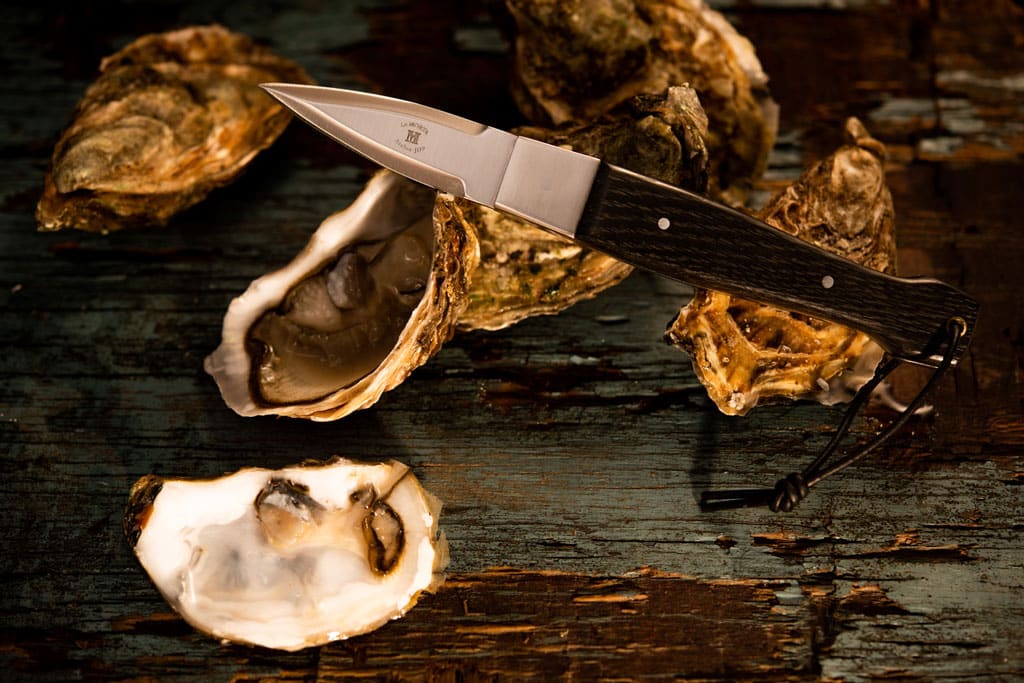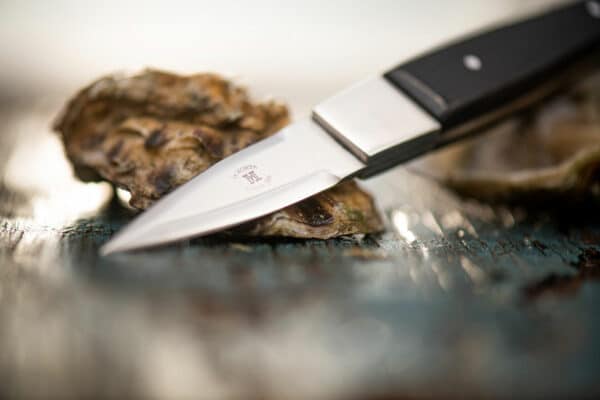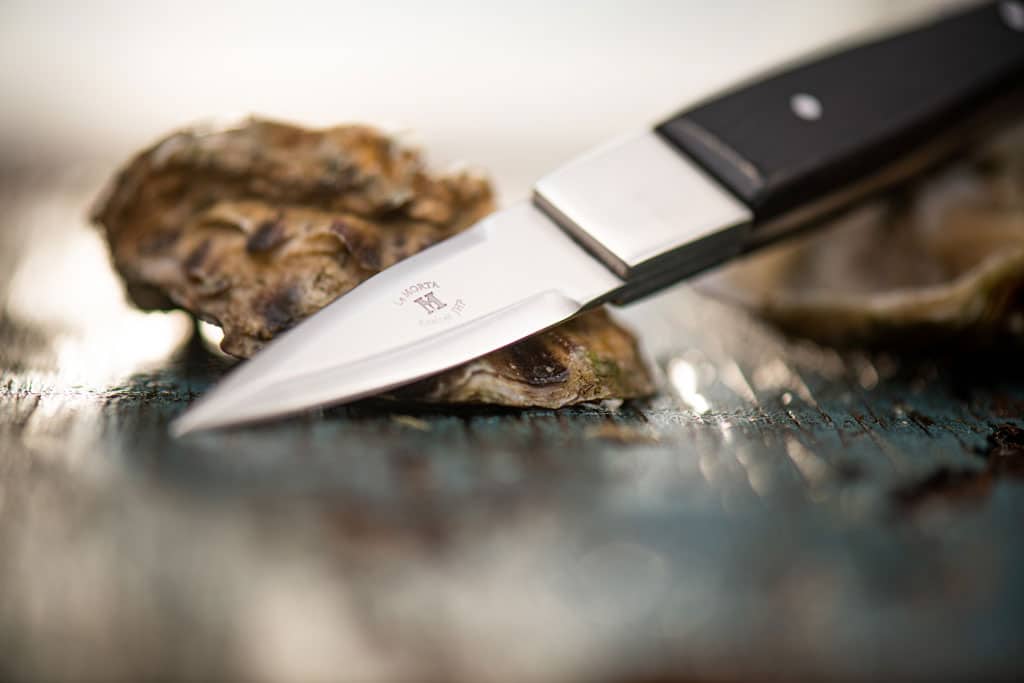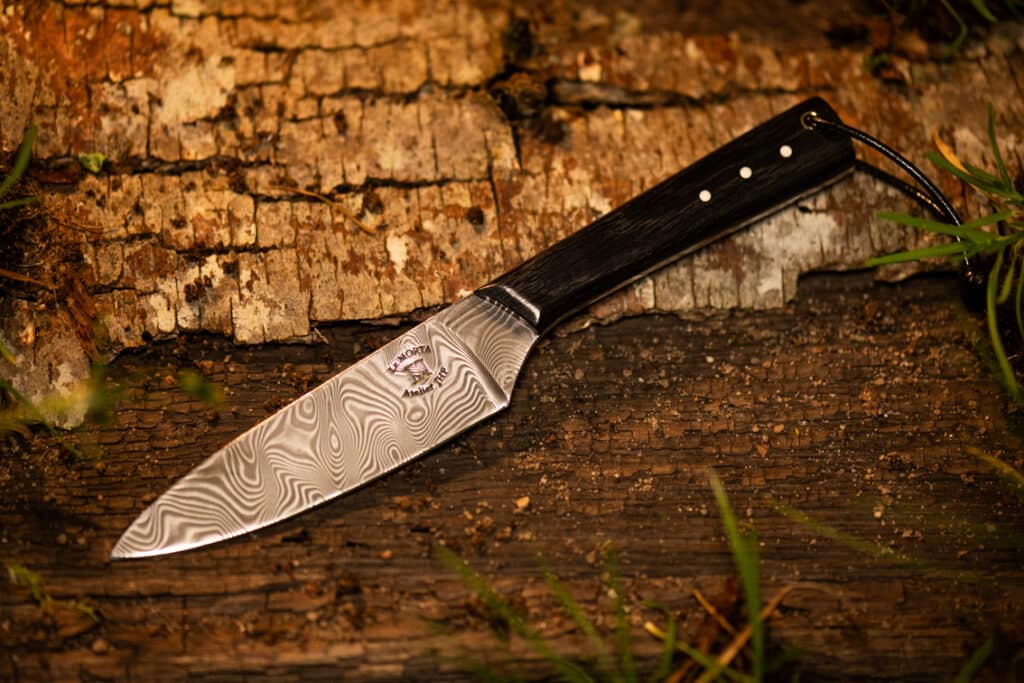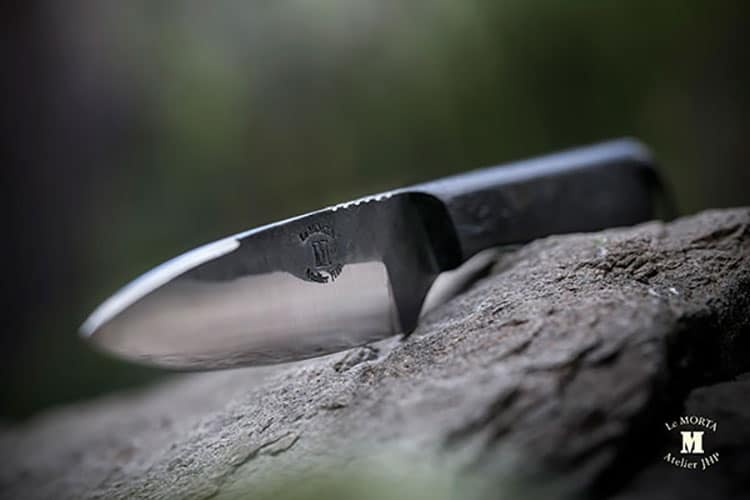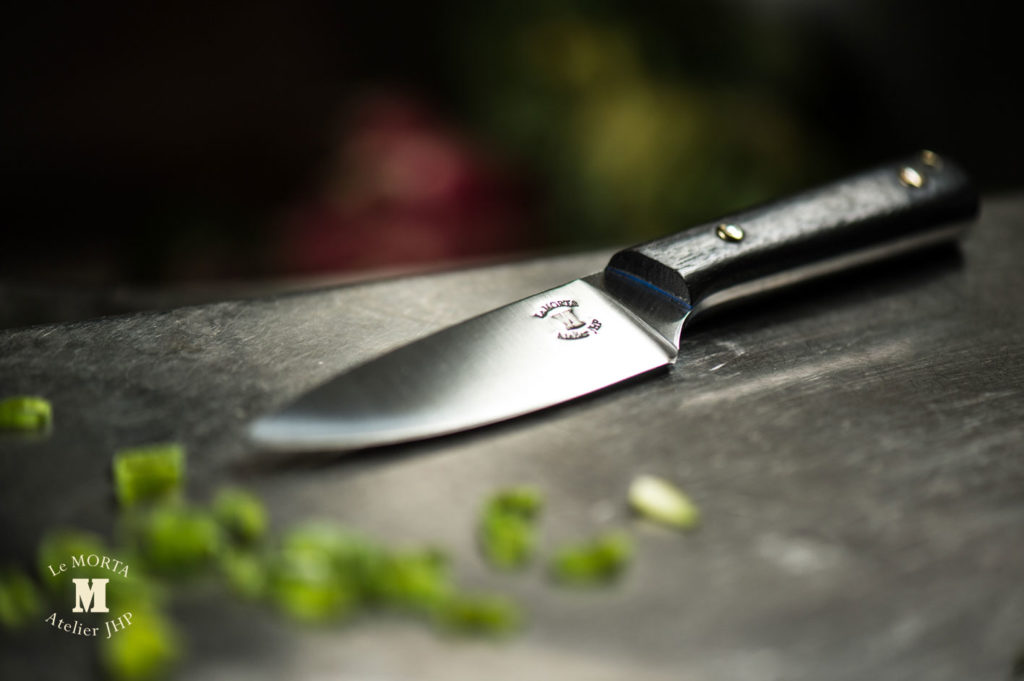The oyster holds a special place in French cuisine. With 20,000 km of coastline, France boasts a strong marine culture. Seafood dishes and holiday feasts are synonymous in many metropolitan homes and top restaurants. Unfortunately, this delicacy comes with the effort of opening it. While opening an oyster may seem simple, precise techniques ensure ideal tasting and maximum safety. Flat or hollow, each type has its shell secrets. How do you open an oyster with a knife? Couteaux Morta answers this delicious question with a few juicy tips.
Open an oyster with a knife : the steps
- Hold the oyster firmly in your palm, flat side up. Keep the rounded side in the palm, hinge (the pointed end) toward your wrist. Right-handers hold the shell in the left hand and the knife in the right. Left-handers do the opposite 😜.
- Place your thumb on the blade for added safety. Insert the knife tip between the two parts of the shell, about two-thirds of the way down the slit, where the muscle is. Be precise and avoid excessive vertical knife movement to prevent chipping the shell and damaging the meat. Prefer back-and-forth movements.
- Gently pivot the blade; when you feel resistance lessen, turn the blade a quarter turn to lever and separate the two shell parts.
- Firmly cut the oyster’s muscle.
- Keep the oyster upright to retain its liquid. Discard the first water as it may contain shell fragments or sand grains. Depending on your guests’ preferences, keep or discard the remaining liquid.
- Carefully place the lid back on the oyster or remove the meat and discard it: it’s a matter of presentation choice.
- Arrange on the serving dish. Keep cool if not consuming immediately.
Some examples of French hollow oysters:
- Marennes-Oléron (Red Label and IGP)
- Isigny Oyster (Normandy)
- Fine de Claire (Marennes)
- Oysters from Mont-Saint-Michel Bay
The flat oyster: tips for easy opening
- Hold the oyster firmly in the palm of your hand (left for right-handers, and vice versa for left-handers). The hollow part of the shell underneath, the lid on top, and the hinge toward you.
- Insert the knife blade into the shell joint. The muscle of the flat oyster is in the middle of the shell length, unlike the hollow oyster.
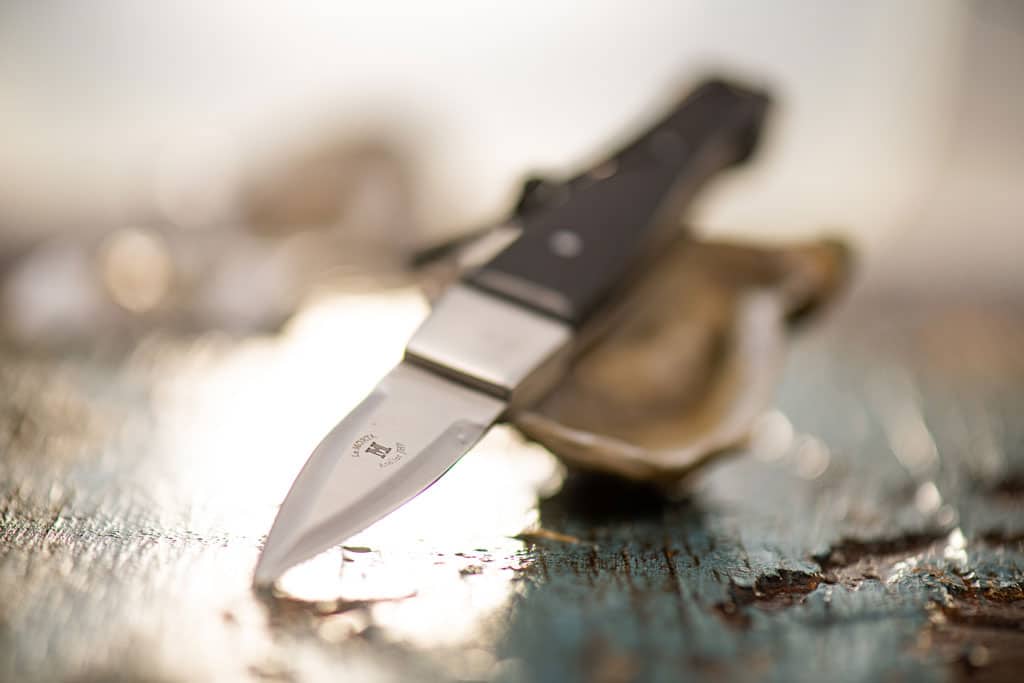
Tip: If the knife stands on its own, it’s deep enough.
- Gently press with your fingers on the back of the knife blade, then make small up-and-down movements. The slight cracking sound indicates your oyster is open.
- Lift the shell.
- Cut the muscle and scrape the lid (upper valve) to detach the mantle.
- Discard the first water then spread the fleshy part for a nice presentation.
- Arrange on the serving dish. Keep cool if not consuming immediately.
Some examples of French flat oysters:
- Belon de Cancale (Northern Brittany; protected by an AOC label)
- Bouzigue (Thau Basin, PACA region)
- Gravette (Arcachon Basin, Cap Ferret)
Best oyster nkife: The oyster seller’s opinion
How to recognize a quality oyster knife? Several criteria to consider:
- A pointed tip blade to facilitate insertion between the shell parts ;
- A short and sturdy blade ;
- A stainless-steel blade to resist iodine effects ;
- No collar around the handle to allow fingers to hold the blade for more safety
If your knife handle is precious (wooden handle), it should be protected by a steel bolster.
Oyster seller’s tip 😉
🔪 For all these criteria, choose the Morta knife.
Safety tips for safely opening an oyster
Doctors attest to it. New Year’s Eve nights are known for the number of cut hands. Opening an oyster isn’t very complicated, but it can be dangerous if you slip.
Severed tendons, infections due to bacteria in oyster water can lead to surgery, ruining your evening and shellfish tasting.
Here are some logical tips from oyster farmers and chefs:
- Hold the knife by the blade, not the handle.
- Never force, prefer small regular movements.
- Protect your left hand if right-handed and right if left-handed, with a cloth, oven mitt, mesh glove, or hand guard.
- Place the thumb of the hand holding the knife on the oyster lid; it acts as a brake in case of a slip.
- Use an oyster knife.
If you don’t have an oyster knife:
- buy one 😉;
- choose a short, pointed, sturdy, stainless steel knife.
Finally, the ultimate solution to open oysters comfortably:
🔪 Buy a batch from a quality producer;
🔪 Uncork a nice bottle;
🔪 Invite a friend to taste them;
🔪 Offer them a drink while they open the oysters 😂.
Let’s move on to tasting: showcasing oysters
Couteaux Morta shares some epicurean secrets…
Accompany your seafood and shellfish dishes with:
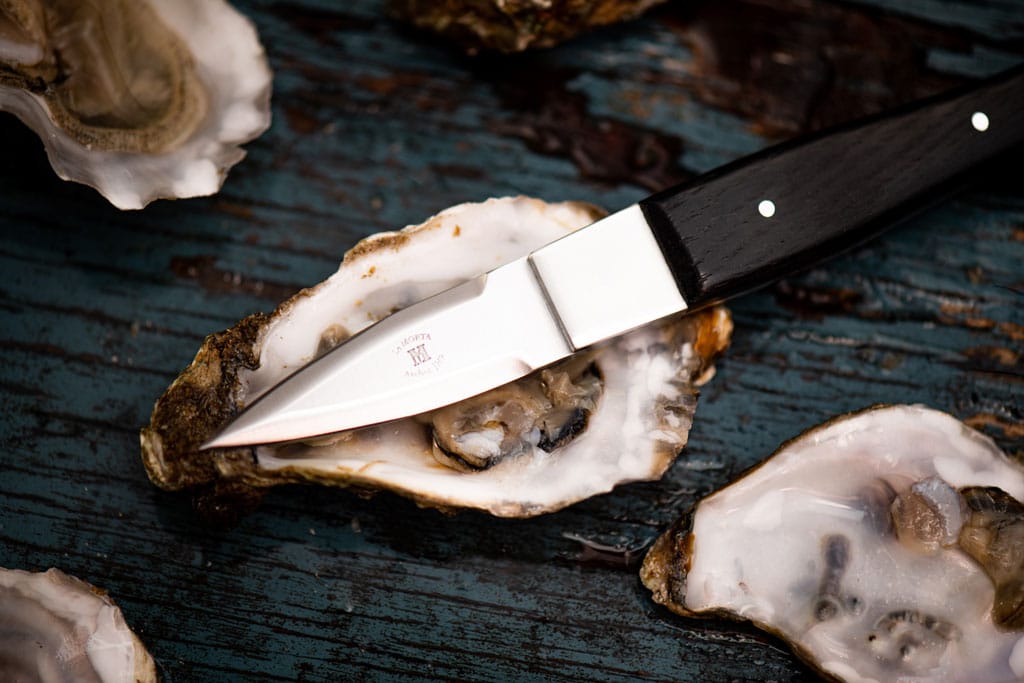
- Lemon juice;
- Shallot vinegar;
- A bit of garlic if you like;
- White wine. Ideally, choose a dry, fruity white wine from the oyster farming region.
- Sancerre adds a citrus note.
- Entre-Deux-Mers and Muscadet Sèvre-et-Maine add a saline and marine touch.
- Chablis stands out with its rich aromas.
- Albarino from Spain or Portugal combines salinity and citrus flavor.
For fine bubble lovers, a brut or semi-brut champagne pairs perfectly with the saline and iodized flavors of oysters.
Finally, red wine lovers should avoid a too powerful wine. Prefer an Atlantic red IGP for its peppery black fruit notes, a lighter and delicate Côte de Bordeaux or Chinon.
- Dense crumb bread, rye bread, or whole wheat bread.
- Some semi-salted AOP butter.
The extra tip 😉
A peaty whisky enhances the iodine, and the peat gains in roundness.
I want the recipe for nettle vinaigrette.
Did you know? Oysters are sold by the dozen or in batches. They are classified by sizes ranging from 0 to 5, indicating their weight.
- Size 0: > 150 grams;
- Size 1: 120 to 150 grams;
- Size 2: 85 to 120 grams;
- Size 3: 65 to 85 grams;
- Size 4: 45 to 65 grams;
- Size 5: < 45 grams.
Other oyster secrets
Traps to avoid when opening oysters
We can’t stress enough to avoid miracle solutions for opening oysters found online: microwave, freezer, or vinegar. Think about quality and freshness!
It’s better to ask for help than use a method that damages your product and makes it lose its good iodized taste.
The best time
At high tide, say the oyster farmers. Otherwise, the ideal time to open oysters is one to two hours before tasting.
Any earlier, you lose freshness. The time between opening and tasting allows the oyster to produce water, guaranteed to be sand-free.
Once opened, keep them in a cool place: between 5 and 15°C.
If the end-of-year holidays are the preferred periods for seafood, oysters are enjoyed all year round. Depending on the season, they are more or less milky.
What to do with oyster shells?
Crushing your shells gives them a second life:
- Add them to the compost to feed future plants with calcium;
- Insert them at the base of your flower pots; they replace clay balls and absorb water at the roots;
- Feed your hens or birds who appreciate the trace elements;
- Place them around plant bases to prevent snails and slugs.
To crush them, place them in a jute bag and break them with a hammer.
Opening oysters is no longer a secret for you. Now, choose well and enjoy sharing and tasting them around a good table with friends. And for that, we trust you completely!
Article written by the sharp and iodized pen of Christelle Lorant 🪶
FAQ – Article summary
How to open an oyster safely and effectively?
To open oysters safely, it’s essential to use an oyster knife specifically designed for this task. The recommended method is to hold the oyster in the palm of your hand with a cloth or oyster glove to avoid injury.
Place the flat side of the oyster up and insert the oyster knife tip between the two shell parts at two-thirds of the way down, where the adductor muscle is located.
Use a rotating motion to lever the blade and open the oyster without slipping.
This method allows you to open oysters easily and without injury, maintaining the iodized taste and freshness of the shellfish.
What criteria do experts say define the best oyster knife?
A quality oyster knife is defined by several essential criteria: a short and sturdy pointed tip blade for easy insertion between the shells, made of stainless steel to resist iodine, and without a collar around the handle for a better, secure grip.
Experienced oyster sellers recommend opting for a knife whose handle allows direct blade holding, offering better control and preventing accidents when opening oysters.
How to ensure optimal oyster tasting?
For optimal tasting, oysters should be accompanied by condiments that enhance their natural flavors without masking them. Lemon juice, shallot vinegar, and a bit of garlic are classic accompaniments.
The choice of wine is also important: a dry, fruity white wine, ideally from the oyster farming region, is perfect.
Among wines, Sancerre, Entre-Deux-Mers, and Chablis are particularly recommended for their ability to complement the salinity and iodized taste of oysters. For a festive touch, a brut or semi-brut champagne pairs perfectly with the marine nuances of oysters.
What precautions should I take to open oysters without injuring myself?
To avoid injury when opening oysters, some precautions are essential: always protect the hand holding the oyster with a specific glove or thick cloth, hold the knife firmly by the blade rather than the handle for better control, and make gentle movements without forcing.
It’s also advised to place the thumb on the oyster lid to stabilize the knife.
If an appropriate oyster knife is unavailable, prefer a small knife with a short, pointed, and sturdy blade.
How to reuse oyster shells after consumption?
Oyster shells can be reused in an ecological and beneficial way. Crushed, they serve as a calcium-rich amendment for compost, improving future plants’ health. Placed at the bottom of flower pots, they act as a drainage system, retaining water at the roots.
Shells can also provide a valuable mineral supplement for hens or birds.
Finally, placed around plants, they form a natural barrier against snails and slugs, protecting the garden without pesticides.
Why is it important to choose the right moment to open oysters before eating them?
Opening oysters at the right time, one to two hours before tasting, is essential to ensure their freshness and optimal quality. This timing allows oysters to produce new water, clean and sand-free, enriching the tasting experience.
Temporary storage in a cool place, between 5 and 15°C, after opening helps preserve this freshness without compromising the iodized taste and unique texture of oysters, offering guests a refined culinary experience.


